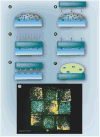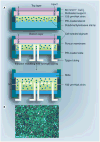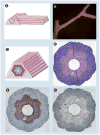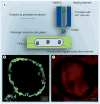Engineering hydrogels as extracellular matrix mimics
- PMID: 20394538
- PMCID: PMC2892416
- DOI: 10.2217/nnm.10.12
Engineering hydrogels as extracellular matrix mimics
Abstract
Extracellular matrix (ECM) is a complex cellular environment consisting of proteins, proteoglycans, and other soluble molecules. ECM provides structural support to mammalian cells and a regulatory milieu with a variety of important cell functions, including assembling cells into various tissues and organs, regulating growth and cell-cell communication. Developing a tailored in vitro cell culture environment that mimics the intricate and organized nanoscale meshwork of native ECM is desirable. Recent studies have shown the potential of hydrogels to mimic native ECM. Such an engineered native-like ECM is more likely to provide cells with rational cues for diagnostic and therapeutic studies. The research for novel biomaterials has led to an extension of the scope and techniques used to fabricate biomimetic hydrogel scaffolds for tissue engineering and regenerative medicine applications. In this article, we detail the progress of the current state-of-the-art engineering methods to create cell-encapsulating hydrogel tissue constructs as well as their applications in in vitro models in biomedicine.
Figures







Similar articles
-
Leveling Up Hydrogels: Hybrid Systems in Tissue Engineering.Trends Biotechnol. 2020 Mar;38(3):292-315. doi: 10.1016/j.tibtech.2019.09.004. Epub 2019 Nov 29. Trends Biotechnol. 2020. PMID: 31787346 Review.
-
Synthetic ECM: Bioactive Synthetic Hydrogels for 3D Tissue Engineering.Bioconjug Chem. 2020 Oct 21;31(10):2253-2271. doi: 10.1021/acs.bioconjchem.0c00270. Epub 2020 Sep 10. Bioconjug Chem. 2020. PMID: 32786365 Review.
-
Advancing Synthetic Hydrogels through Nature-Inspired Materials Chemistry.Adv Mater. 2024 Oct;36(42):e2404235. doi: 10.1002/adma.202404235. Epub 2024 Jul 1. Adv Mater. 2024. PMID: 38896849 Review.
-
Engineered Protein Hydrogels as Biomimetic Cellular Scaffolds.Adv Mater. 2024 Nov;36(45):e2407794. doi: 10.1002/adma.202407794. Epub 2024 Sep 5. Adv Mater. 2024. PMID: 39233559 Review.
-
Bioinspired Hydrogels to Engineer Cancer Microenvironments.Annu Rev Biomed Eng. 2017 Jun 21;19:109-133. doi: 10.1146/annurev-bioeng-071516-044619. Annu Rev Biomed Eng. 2017. PMID: 28633560 Free PMC article. Review.
Cited by
-
Nanofibrillar hydrogel scaffolds from recombinant protein-based polymers with integrin- and proteoglycan-binding domains.J Biomed Mater Res A. 2016 Dec;104(12):3082-3092. doi: 10.1002/jbm.a.35839. Epub 2016 Aug 16. J Biomed Mater Res A. 2016. PMID: 27449385 Free PMC article.
-
Three Dimensional Quercetin-Functionalized Patterned Scaffold: Development, Characterization, and In Vitro Assessment for Neural Tissue Engineering.ACS Omega. 2020 Aug 25;5(35):22325-22334. doi: 10.1021/acsomega.0c02678. eCollection 2020 Sep 8. ACS Omega. 2020. PMID: 32923790 Free PMC article.
-
Extracellular Matrices as Bioactive Materials for In Situ Tissue Regeneration.Pharmaceutics. 2023 Dec 13;15(12):2771. doi: 10.3390/pharmaceutics15122771. Pharmaceutics. 2023. PMID: 38140112 Free PMC article. Review.
-
A Comparative Review of Natural and Synthetic Biopolymer Composite Scaffolds.Polymers (Basel). 2021 Mar 30;13(7):1105. doi: 10.3390/polym13071105. Polymers (Basel). 2021. PMID: 33808492 Free PMC article. Review.
-
Surface-Modified Bilosomes Nanogel Bearing a Natural Plant Alkaloid for Safe Management of Rheumatoid Arthritis Inflammation.Pharmaceutics. 2022 Mar 3;14(3):563. doi: 10.3390/pharmaceutics14030563. Pharmaceutics. 2022. PMID: 35335939 Free PMC article.
References
Publication types
MeSH terms
Substances
Grants and funding
LinkOut - more resources
Full Text Sources
Other Literature Sources
